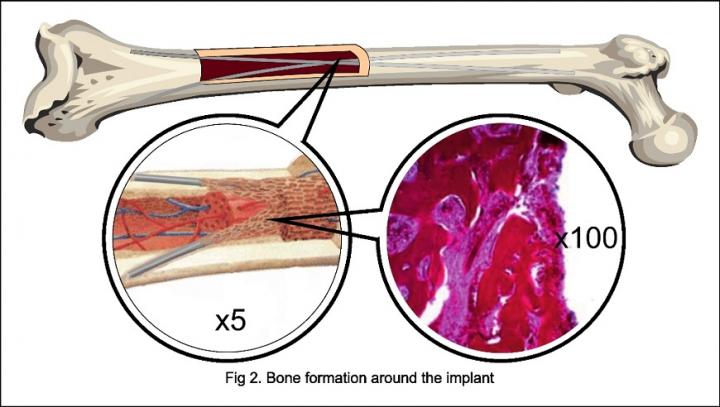Russian scientists developed advanced implants for the Ilizarov orthopedic system

Credit: Tomsk Polytechnic University
The implants developed by TPU scientists passed preclinical trials In the Ilizarov Orthopedic Center (Kurgan, Russia). These implants form part of the Ilizarov system variation applied for lengthening and correcting the deformations of long tubular bones in children. During the preclinical tests, Tomsk implants made it possible to reduce the terms of limb lengthening two times. The outcomes of research and tests were published in the journal Biomedical Materials.
In the early 50s of the 20th century, a Soviet surgeon Gavriil Ilizarov developed a special system for the correction of body proportions, leg curvature, congenital deformities, clubfoot, foot bone anomalies in adults and children. Its feature was that the bone fixing elements were outside the body. This system underlies the method of transosseous osteosynthesis currently used in over 60 countries of the world. The modern Ilizarov system consists of titanium or carbon-fiber rods that are fixed on a limb by plates of various forms and interconnected by moving rods. Physicians manipulate a bone via the movement of the rods.
As.Prof. Sergey Tverdokhlebov from the Weinberg Research Center, a co-author of the study says:
‘In cases when it is necessary to lengthen a bone, for example, when a child has legs of different length that can lead to various pathologies in the future, – its parts are dissected and then are slowly moved apart.
We developed an implant that presents a titanium or steel needle and used as a ‘conductor’ that helps to form new bone tissue.
Such a needle is inserted inside a tubular bone. The kind of implants helps to accelerate bone regeneration and as a result to reduce the rehabilitation period.’
Needle implants developed at TPU are made of steel and BT6 compounds (an alloy of titanium with aluminum and vanadium) typical for implanting materials. TPU scientists coated them with special materials. Steel needle implants were coated with a composite material based on piezoelectric fluorocarbon plastic and hydroxyapatite by aerodynamic formation. Titanium implants were coated with calcium phosphate by micro-arc oxidation.
Another co-author of the study Evgeniy Bolbasov, a research fellow of the TPU Laboratory for Plasma Hybrid Systems explains:
‘TPU scientists have already developed technologies for manufacturing implants and coating deposition. The coatings are close to a natural bone tissue by their composition and physical characteristics thus improving the survival rate of implants.
There is an additional important fact. Big tubular bones have a bone marrow containing multiple mesenchymal stem cells, which can differentiate into various types of cells. The implant coating imitating bone composition make stem cells regenerate into a bone tissue. The new bone tissue begins to grow intensively around the implant.
After successful regeneration, the implant is removed.’
In the case of titanium implants and hydroxyapatite coatings, mesenchymal stem cells react to the chemical composition of the coating and therefore start to differentiate.
In case of steel implants, they react to piezoelectric properties of coatings.
At the stage of preclinical trials, the experts from the Ilizarov Center compared classic steel, titanium implants without coating with coated implants developed at TPU. The trials showed that Tomsk implants made it possible to restore 4 cm of a bone tissue within 35 days and with classic implants – within 70 days.
‘Meantime, using our implants the density of newly formed tissue was 2.5 times higher and much closer to the norm of healthy bone than with classic implants. Besides, there was the acceleration of both bone tissue and accompanying muscle and connective tissues,’ notes Evgeniy Bolbasov.
Currently, the Ilizarov Center runs limited clinical trials.
###
Media Contact
Kristina Nabokova
[email protected]
7-382-270-5685
Original Source
https:/
Related Journal Article
http://dx.




